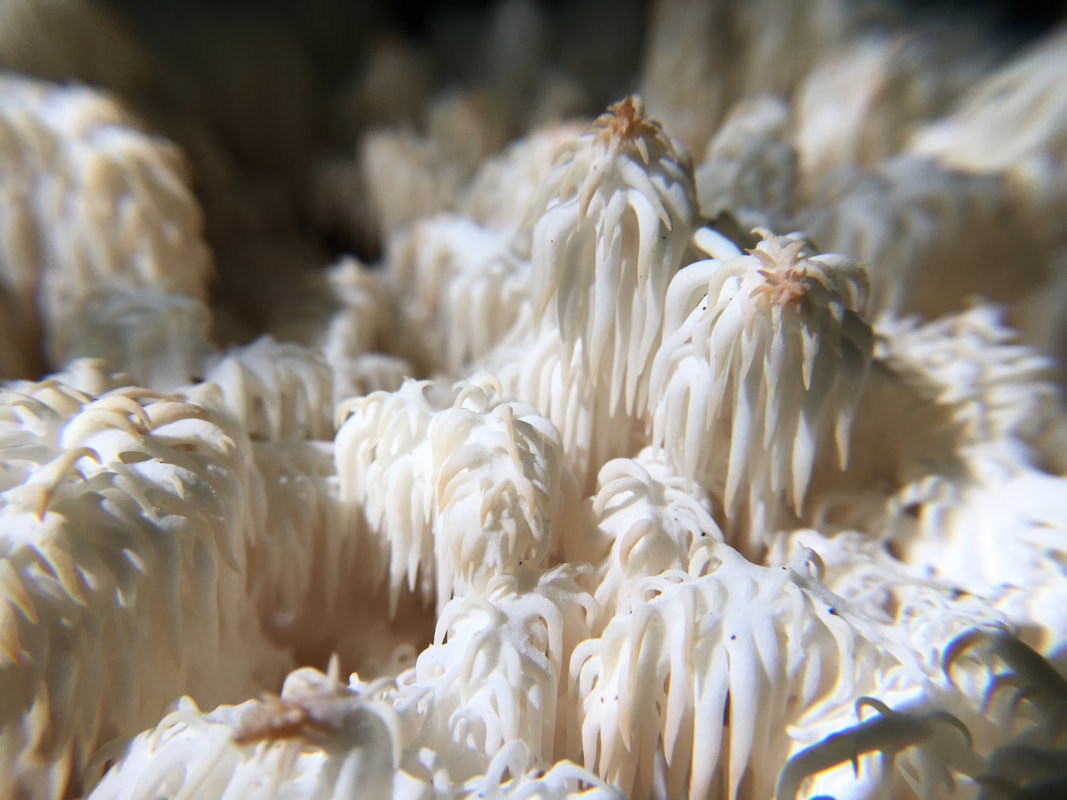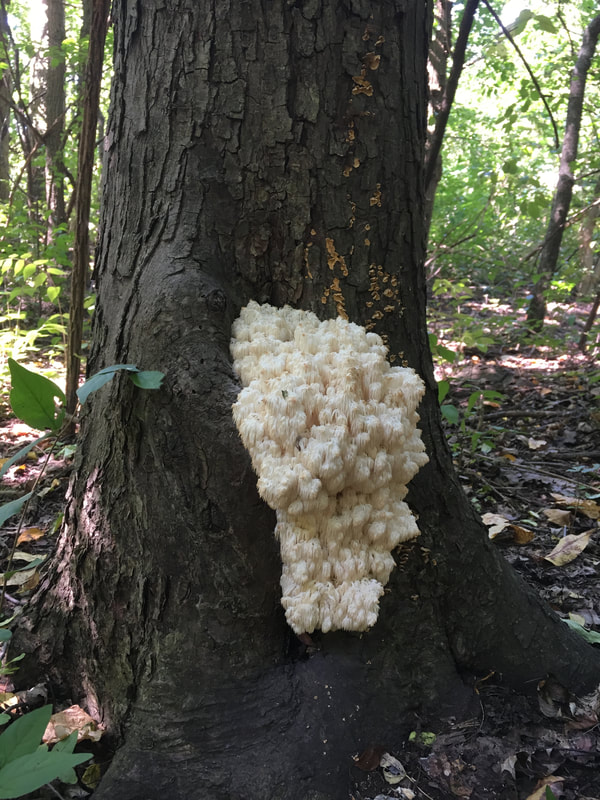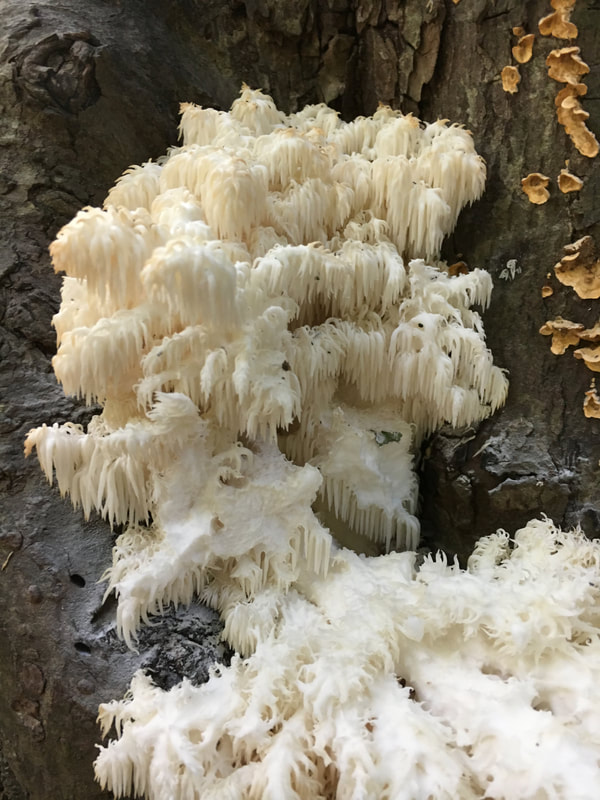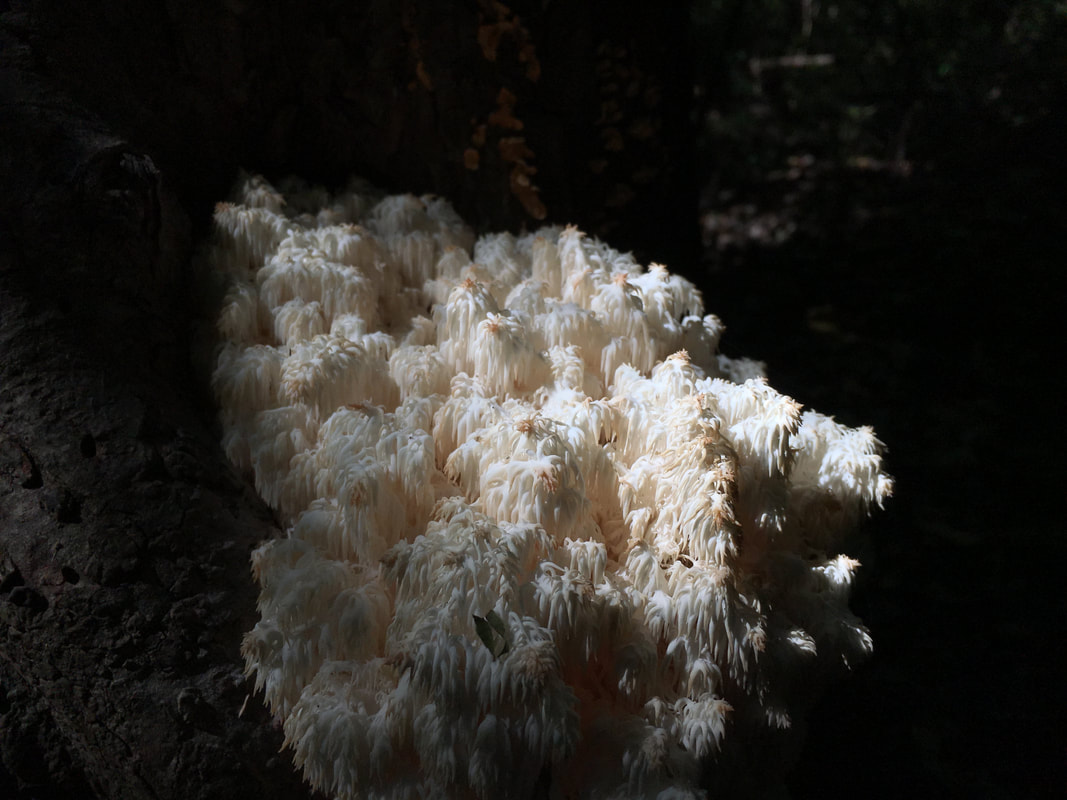|
Mycobank Taxonomy: Fungi, Dikarya, Basidiomycota, Agaricomycotina, Agaricomycetes, Russulales, Hericiaceae, Hericium This magnificent mushroom was growing right off a busy path in the woods. I watched it for days hoping it would grow bigger but not get snatched up by somebody else. Finally, it was ready (and I actually had time to harvest and cook it). Unlike more familiar edible mushrooms with gills or pores, Hericium coralloides has icicle-like spines, or teeth, similar to hedgehog mushrooms (Hydnum spp.). We might be inclined to lump these toothed mushrooms together into the same group, but spines are not a trait indicating shared ancestry. Rather, spines convergently involved in very distantly related taxonomic groups – in this case, Hericium in Russulales and Hydnum in Cantharellales – to achieve a similar mechanism of spore dispersal. Four Hericium species occur in North America, three of which are found in the Northeast. These are H americanum, H. coralloides, and H. erinaceus. The fourth, H. abietis, only occurs in the Pacific Northwest. All are excellent edibles. Separating the three northeastern species (if you care) is relatively straightforward. H. erinaceus produces long spines on an unbranched structure - kind of like a giant pom pom. The other two hang their spines on branches and can be separated by the length of the spines. Those on H. coralloides are up to 1 cm in length whereas H. americanum has spines up to 4 cm long. In immaturity, all three species are unbranched and have small teeth, making identification impossible without microscopy or sequencing. Although I hesitate to discuss putative biomedical benefits of mushrooms, I would be remiss to not mention the research being conducted on potential therapeutic applications of Hericium species, in particular H. erinaceus. There is a whole lot of excitement on the possibility of consuming Hericium species to counteract neurodegenerative disorders; however, very few studies on this topic have been published in reputable journals using robust methodologies. Recently, though, a publication in PLoS ONE (Li et al. 2019) took a different approach and instead researched whether the compound erinacine A extracted from H. erinaceus mycelium promoted longevity in fruit flies and mice. They found that both species lived longer on average when fed this extract – approximately 20% longer (an extra two months) for mice on the highest dose compared to the control. While this research is exciting for its potential implications for human health, we are far from understanding how erinacine A affects the mental functioning and longevity of our species. Also note that erinacine A was extracted from the mycelium and concentrated before being administered to the flies and mice, so we shouldn't necessarily expect the actual fruiting bodies (the mushroom that we eat) to supply any appreciable quantity of erinacine A. Regardless of any real or imagined health benefits of eating Hericium mushrooms, a walk in the woods and a homemade meal with one's community might be one of the best things for an individual's wellbeing. Regarding edibility, Hericium mushrooms excel for their seafood-like taste and texture. They are not at all fishy, but something about them screams... crab cake, probably because I feel like I am scuba diving when I find one. Never would I have thought that crab cakes could be made vegan and taste so good, but Hericium coralloides achieved it. Modifying this recipe by Forager Chef Alan Bergo, I substituted vegan cheese for the parmesan, chia eggs for the real eggs, vegan Worcestershire sauce for the regular anchovy stuff, and – my favorite – Miyoko's vegan butter for real butter. The final product was excellent – crispy, rich, and golden brown on the outside, soft, sweet, and crab-like mushroom meat on the inside. These Hericium crab cakes are uncannily like the real stuff and just as good, too. In conclusion, I dedicate this post not to Hericium coralloides and its potential to allow us to live forever, but to chia seeds. It's not easy to compete with Goliath chicken eggs, but in their gelatinous aggregation, these zygotes rallied together and were a sight to behold, binding the patty together with a champion's strength. The seeds that were on the outside of the patty even got extra crispy, resulting in a nice texture bonus. Great job, chia! SpecimenACD0189, 26 September 2019; Washtenaw Co., MI, USA; leg. Alden C. Dirks, det. Alden C. Dirks, MICH 352193. ReferencesLi, I.-C., Lee, L.-Y., Chen, Y.-J., Chou, M.-Y., Wang, M.-F., Chen, W.-P., … Chen, C.-C. (2019). Erinacine A-enriched Hericium erinaceus mycelia promotes longevity in Drosophila melanogaster and aged mice. PLoS ONE, 14(5), 1–13. https://doi.org/10.1371/journal.pone.0217226 Online Resources
0 Comments
Your comment will be posted after it is approved.
Leave a Reply. |
PermalinksProject Introduction Top EdiblesHericium coralloides
Laetiporus sulphureus Morchella americana Polyporus umbellatus Suillus ampliporus Archives
April 2023
Categories |
|
|
Terms of Use, Liability Waiver, and Licensing
The material on aldendirks.com is presented for general informational and educational purposes only, and under no circumstances is to be considered a substitute for identification of an actual biological specimen by a person qualified to make that judgment. Some fungi are poisonous; please be cautious. All images on this website are licensed under Attribution-NonCommercial-NoDerivatives 4.0 International (CC BY-NC-ND 4.0). |




 RSS Feed
RSS Feed




